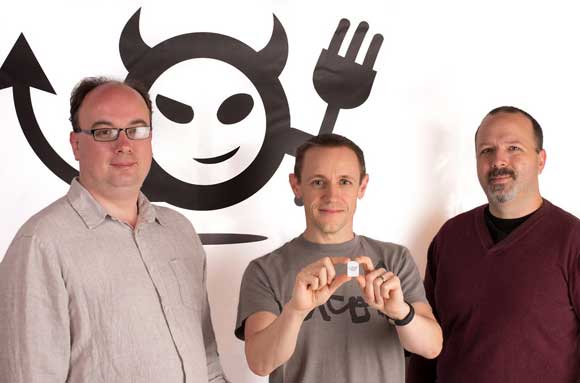 Home automation is a hot category that just got even hotter. And possibly, just a bit easier. Today Electric Imp is announcing the Imp, a cloud-based approach to monitoring and managing everything you own.
Home automation is a hot category that just got even hotter. And possibly, just a bit easier. Today Electric Imp is announcing the Imp, a cloud-based approach to monitoring and managing everything you own.
The venture-backed startup in Los Altos, California, is taking a manufacturer-centric approach to the automation market — so don’t expect to be able to buy an Imp to retrofit existing devices tomorrow. Electic Imp is releasing a developer preview bundle in June, giving manufacturers the tools to make their devices Imp-compatible.

Above: The Imp chip
Think pre-warming your house when returning from a vacation, or watering your lawn via smartphone. Or turning on the TV and a few lights while you’re out for dinner to convince potential crooks you’re still at home. And maybe, a fridge that re-orders food as you’re about to run out.
In a statement provided to VentureBeat, founder and CEO of Electric Imp Hugo Fiennes said “Until now, creating connected devices was a huge challenge for any vendor.” The home automation category is a currently mess of competing standards and technologies. Device communication protocols include Wi-Fi, Firewire, USB, and infrared, and home automation product ecosystems include X10, UPB, mControl, HomeSeer, Control4, Vivint, PowerHome, and ActiveHome Pro, among others.
Electric Imp intends to solve that by reducing complexity. Install a tiny Imp card, connect it to your home Wi-Fi, and control it via the Imp cloud service. Each device in your home instantly knows about the other devices and can communicate with them. Then use your browser or smartphone anywhere on the planet to control your home.
The current reality is a little more complex: you have to choose control and automation software, find, purchase, and install devices specifically rated to interoperate with that system, and install software or an embedded server to manage it all.
Fiennes says that’s all in the past. “Electric Imp changes all this by bringing the power of an easy to use, cloud-based service to almost any device and allowing the internet to interact with everyday objects.” Interaction will be possible on three levels: Imp to Imp, Imp to people,, and Imp to services.
The approach makes sense, since it’s embedding most of the intelligence of the system in the cloud. It’s reminiscent of developing nations skipping legacy telephone grids and moving straight to cellular communications. In addition, by taking a manufacturer-centric approach, Electric Imp has a chance to disrupt currently consumer-focused home automation market. According to a company statement, integrating an Imp slot into a device should cost less than a dollar.
But there’s a great deal of existing competition in this space. In addition, powerful players like Microsoft are bringing solutions to market such as HomeOS, AT&T wants to provide our Digital Life, and Google would love us to all have Android@Home. Can an iOS or Apple iHome system be far behind?
To win, Electric Imp is going to have to innovate fast, go to market hard, and find some luck along the way. The company just closed a series A round of funding from Redpoint Ventures and Lowercase Capital, which should help. And the co-founders do have some impressive credentials: Hugo Fiennes is a former iPhone engineering manager, and Kevin Fox, another co-founder, designed Gmail. VentureBeat spoke to Tom Tunguz, principal of Redpoint Ventures, who said: “Every great product has a little bit of magic. This team has worked on two of the most successful consumer products in history.” If Electric Imp can bring some Apple and Google magic to bear, they have a shot at success.
If they do, perhaps by Christmas we’ll see devices labelled “Imp Inside.”

Above: Electric Imp founders: Peter Hartley, Hugo Fiennes, Kevin Fox. Fiennes is holding an Imp.
Photo credit: Hakan Dahlstrom on Flickr


